Semi-Supervised Learning Using Randomized Mincuts - PowerPoint PPT Presentation
Title:
Semi-Supervised Learning Using Randomized Mincuts
Description:
Semi-Supervised Learning Using Randomized Mincuts Avrim Blum, John Lafferty, Raja Reddy, Mugizi Rwebangira Carnegie Mellon Motivation Often have little labeled data ... – PowerPoint PPT presentation
Number of Views:178
Avg rating:3.0/5.0
Title: Semi-Supervised Learning Using Randomized Mincuts
1
Semi-Supervised Learning Using Randomized Mincuts
- Avrim Blum, John Lafferty, Raja Reddy, Mugizi
Rwebangira - Carnegie Mellon
2
Motivation
- Often have little labeled data but lots of
unlabeled data. - We want to use the relationships between the
unlabeled examples to guide our predictions. - Assumption Similar examples should generally
be labeled similarly."
3
Learning using Graph MincutsBlum and Chawla
(ICML 2001)
4
Construct an (unweighted) Graph
5
Add auxiliary super-nodes
6
Obtain s-t mincut
-
Mincut
7
Classification
-
Mincut
8
- Problem
- Plain mincut gives no indication of its
confidence on different examples.
- Solution
- Add random weights to the edges.
- Run plain mincut and obtain a classification.
- Repeat the above process several times.
- For each unlabeled example take a majority vote.
- Margin of the vote gives a measure of the
confidence.
9
Before adding random weights
-
Mincut
10
After adding random weights
-
Mincut
11
- PAC-Bayes
- PAC-Bayes bounds show that the average of
several hypotheses that are all consistent with
the training data will probably be more accurate
than any single hypothesis. - In our case each distinct cut corresponds to a
different hypothesis. - Hence the average of these cuts will probably be
more accurate than any single cut.
12
- Markov Random Fields
- Ideally we would like to assign a weight to each
cut in the graph (a higher weight to small cuts)
and then take a weighted vote over all the cuts
in the graph. - This corresponds to a Markov Random Field model.
- We dont know how to do this efficiently, but we
can view randomized mincuts as an approximation.
13
Related Work Gaussian Fields
- Zhu, Gharamani and Lafferty (ICML 2003).
- Each unlabeled example receives a label that is
the average of its neighbors. - Equivalent to minimizing the squared difference
of the labels.
14
- How to construct the graph?
- k-NN
- Graph may not have small balanced cuts.
- How to learn k?
- Connect all points within distance d
- Can have disconnected components.
- How to learn d?
- Minimum Spanning Tree
- No parameters to learn.
- Gives connected, sparse graph.
- Seems to work well on most datasets.
15
Experiments
- ONE vs. TWO 1128 examples .
- (8 X 8 array of integers, Euclidean distance).
- ODD vs. EVEN 4000 examples .
- (16 X 16 array of integers, Euclidean distance).
- PC vs. MAC 1943 examples .
- (20 newsgroup dataset, TFIDF distance) .
16
ONE vs. TWO
17
ODD vs. EVEN
18
PC vs. MAC
19
Accuracy Coverage PC vs. MAC (12 labeled)
20
- Conclusions
- We can get useful estimates of the confidence of
our predictions. - Often get better accuracy than plain mincut.
- Minimum spanning tree gives good results across
different datasets.
21
- Future Work
- Sample complexity lower bounds (i.e. how much
unlabeled data do we need to see?). - More principled way of sampling cuts?
22
THE END
23
Questions?































